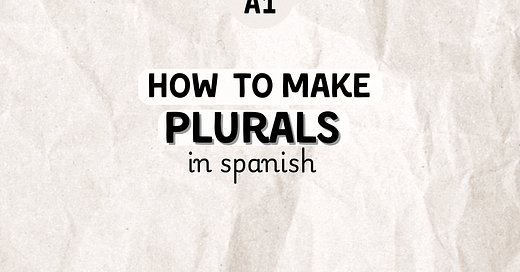Plurals in Spanish
Understanding how to form plurals in Spanish is a key part of learning the language. Whether you’re a beginner or intermediate student, mastering plurals will give you more confidence in speaking and writing. 🌟 In this post, we’ll dive into the rules for making nouns plural in Spanish, highlighting common patterns, exceptions, and irregularities. Plus, we’ve included an interactive quiz at the end to test your knowledge and reinforce what you’ve learned!
1. The Basics of Plurals in Spanish 📝
In Spanish, making plurals is fairly straightforward once you know the basic rules. Let's look at the general guidelines:
Rule 1: Nouns Ending in Vowels
If a noun ends in a vowel (a, e, i, o, u), simply add -s to make it plural.
Examples:
libro (book) ➡️ libros (books)
flor (flower) ➡️ flores (flowers)
coche (car) ➡️ coches (cars)
Rule 2: Nouns Ending in Consonants
If a noun ends in a consonant, add -es to form the plural.
Examples:
mujer (woman) ➡️ mujeres (women)
papel (paper) ➡️ papeles (papers)
animal (animal) ➡️ animales (animals)
Rule 3: Nouns Ending in “-z”
If a noun ends in -z, change the z to -ces when making it plural.
Examples:
luz (light) ➡️ luces (lights)
pez (fish) ➡️ peces (fishes)
voz (voice) ➡️ voces (voices)
2. Irregular Plurals in Spanish ⚠️
Not all nouns follow the regular pluralization rules. Some are irregular, meaning they have their own unique plural forms that you’ll need to memorize. Here are some of the most common irregular plurals:
el hombre (man) ➡️ los hombres (men)
la mujer (woman) ➡️ las mujeres (women)
el niño (boy) ➡️ los niños (boys)
la niña (girl) ➡️ las niñas (girls)
Some nouns that end in -ión or -dad also have irregular plural forms:
nación (nation) ➡️ naciones (nations)
ciudad (city) ➡️ ciudades (cities)
televisión (television) ➡️ televisiones (televisions)
3. Special Cases: Words Ending in “-e” or “-ista”
Some nouns that end in -e or -ista can be either masculine or feminine, and their plurals are formed in the usual way, but they don't change in gender. You just add -s or -es.
Examples:
el estudiante (the student - masculine) ➡️ los estudiantes (the students)
la cantante (the singer - feminine) ➡️ las cantantes (the singers)
4. Gender and Number Agreement in Plurals
When making plurals, the gender of the noun (masculine or feminine) must also match with the adjectives that describe it. For example:
El coche rojo (The red car - masculine) ➡️ Los coches rojos (The red cars - masculine)
La flor roja (The red flower - feminine) ➡️ Las flores rojas (The red flowers - feminine)
5. Pluralization of Nouns Ending in “-s” or “-x”
Some nouns that already end in -s or -x don’t require an additional -s to form the plural. The word stays the same.
Examples:
el lunes (Monday) ➡️ los lunes (Mondays)
el complex (complex) ➡️ los complexes (complexes)
Interactive Exercise: Plural Matching Challenge!
Test your understanding of pluralization rules with this fun, interactive quiz. Match each noun to the correct plural form. Ready? Let’s go!
Click here to practice.
Conclusion:
Mastering pluralization in Spanish may seem like a lot at first, but with practice, you'll be forming plurals like a pro. Keep in mind the basic rules, remember those irregular cases, and don't forget to test yourself regularly! 🎉
🚀 Want to Learn More?
📅 Book a 1-on-1 Spanish Lesson with me! 👉 Click here to schedule!
🎥 Subscribe to My YouTube Channel for more fun lessons! 👉 Subscribe Now!






